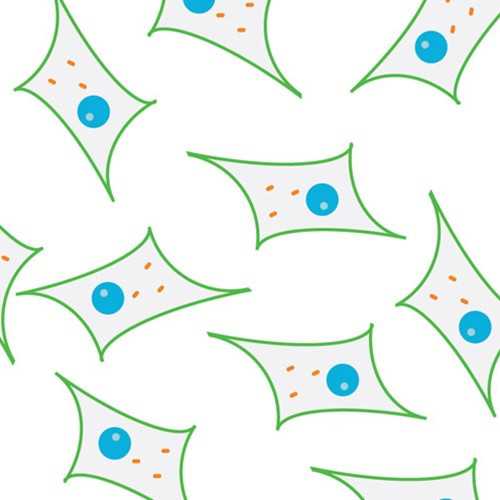MMMbz Blasticidin/Zeocin Resistant Cell Line
The MMM cell line is very effective in supporting the growth of human embryonic stem (hES) cells. This line has been made resistant to blasticidin and zeocin (MMMbz), which are the most efficient drugs available for selection of hES cells transfected with exogenous genes.
Highlights:
- Indefinite lifespan (immortalized) and rapid growth rate
- Better support of hES cells, compared to MEFs
- Excellent ability to support growth of difficult-to-grow hES lines, with maintenance of the pluripotential state
- Resistance to blasticidin and zeocin makes it possible to select, by drug treatment, for hES cells into which exogenous genes have been introduced, without killing the supporting MMM
Human embryonic stem (ES) cells are usually co-cultivated with supporting cells consisting of short-term cultures of fibroblasts (not an immortalized line) in a medium lacking serum. The immortalized MMMbz cell line supports the multiplication of H9 cells better than the 3T3 line. It supports the growth of H9 cells as well as do available short-term fibroblast cultures, but maintains more effectively the stem cell character of the H9 cells, judging by their better retention of Oct4. The cells are also resistant to blasticidin and zeocin, the most efficient antibiotics for selection of stable transformants.
From the laboratories of Howard Green, MD, Harvard University and Walid Kuri-Harcuch, PhD, Centro de Investigacion y Estudios Avanzados del IPN (CINVESTAV).
 Part of The Investigator's Annexe program.
Part of The Investigator's Annexe program.
The MMM cell line is very effective in supporting the growth of human embryonic stem (hES) cells. This line has been made resistant to blasticidin and zeocin (MMMbz), which are the most efficient drugs available for selection of hES cells transfected with exogenous genes.
Highlights:
- Indefinite lifespan (immortalized) and rapid growth rate
- Better support of hES cells, compared to MEFs
- Excellent ability to support growth of difficult-to-grow hES lines, with maintenance of the pluripotential state
- Resistance to blasticidin and zeocin makes it possible to select, by drug treatment, for hES cells into which exogenous genes have been introduced, without killing the supporting MMM
Human embryonic stem (ES) cells are usually co-cultivated with supporting cells consisting of short-term cultures of fibroblasts (not an immortalized line) in a medium lacking serum. The immortalized MMMbz cell line supports the multiplication of H9 cells better than the 3T3 line. It supports the growth of H9 cells as well as do available short-term fibroblast cultures, but maintains more effectively the stem cell character of the H9 cells, judging by their better retention of Oct4. The cells are also resistant to blasticidin and zeocin, the most efficient antibiotics for selection of stable transformants.
From the laboratories of Howard Green, MD, Harvard University and Walid Kuri-Harcuch, PhD, Centro de Investigacion y Estudios Avanzados del IPN (CINVESTAV).
 Part of The Investigator's Annexe program.
Part of The Investigator's Annexe program.
| Product Type: | Cell Line |
| Name: | MMMbz |
| Cell Type: | Immortalized embryonic mouse fibroblasts with drug resistance to blasticidin and zeocin. |
| Accession ID: | CVCL_S558 |
| Morphology: | Fibroblastic |
| Source: | 12-13 day mouse embryos |
| Organism: | Mouse |
| Biosafety Level: | BL1 |
| Subculturing: | Subculture the cells once they reach 60-80% confluency. NOTE: It is very important not to let the cells get confluent or their ability to support hES cells will be diminished. |
| Growth Conditions: | Cells grow in 10% CO2 at 37C in a humidified incubator. Media: DMEM supplemented with 10% bovine calf serum. Split the cells at a density of ~ 3.3 x 103cells/cm2. Feed every 2 to 3 days with DME supplemented with 10% bovine calf serum. DO NOT use fetal bovine serum (Recommended serum: GE Healthcare Iron-Supplemented BVN CLF 500ml; Cat.SH30072.03). |
| Cryopreservation: | DMEM with 10% bovine calf serum containing 10% sterile DMSO |
| Storage: | Liquid nitrogen |
| Shipped: | Dry ice |
MMM cells are an immortalized murine cell line developed from embryos of 12-13 days of gestation. The line is described in an article entitled "An Immortalized Drug-Resistant Cell Line Established From 12-13 Day Mouse Embryos For The Propagation Of Human Embryonic Stem Cells" by S. Iuchi, M. Marsch-Moreno, C. Velez-DelValle, K. Easley, W. Kuri-Harcuch and H. Green,published in Differentiation (2006) 74: 160-166.
For antibiotic selection: zeocin at 100µg/ml and blasticidin S at 5µg/ml in DME + 10% bovine calf serum.
To support hES cells, irradiate MMMbz cells with 6000 rads and plate the cells at 1.3 x 105/cm2 (this corresponds to 2.6 x 106 cells per 60 mm dish and to 1.2 x 106 per 35 mm dish) in DME + 10% bovine calf serum. Add hES cells on the following day in SR medium, which consists of Knockout DMEM, supplemented with 20% Knockout Serum Replacement (Knockout SR), 1mM L-glutamine, 1% MEM non-essential amino acids, 0.1 mM 2-mercaptoethanol (BME), and bFGF at 4 ng/ml.
- Iuchi S, Marsch-Moreno M, Velez-DelValle C, Easley K, Kuri-Harcuch W, Green H. An immortalized drug-resistant cell line established from 12-13-day mouse embryos for the propagation of human embryonic stem cells. Differentiation. 2006 Apr;74(4):160-6.
If you publish research with this product, please let us know so we can cite your paper.


